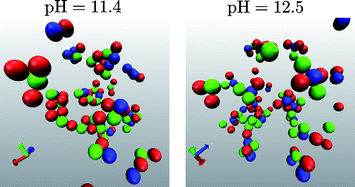We study numerically the aggregation processes with three types of charged colloidal particles, PbO–lead oxide, MHC–magnesium hydroxy carbonate, and Nb2O5–niobium oxide, interacting in the aqueous suspensions for Pb(Mg1/3Nb2/3)O3 ceramic synthesis. Using the Monte Carlo simulations we focus on the kinetics and structure of various types of precursor clusters that may form at different pH conditions. The parameters of the interaction potentials and the particle sizes are taken to closely correspond to the experimental situations in [Trefalt et al., J. Am. Ceram. Soc., DOI: 10.1111/j.1551-2916.2011.04443.x, 2011], where it was shown that the pyrochlore phase, which deteriorates the electrical properties of the Pb(Mg1/3Nb2/3)O3 ceramics, results from the suspension with pH = 11.4, while the pure perovskite powder is formed when pH = 12.5. Our simulations reveal a large population of clusters with close contacts between PbO and Nb2O5 at pH = 11.4, which thus enable the pyroclore phase to form. Whereas, at pH = 12.5 the competition between the repulsive and the attractive interactions changes in favor of the assembly of the equilibrium clusters in which MHC particles effectively separate PbO and Nb2O5. We also explore how the varying size of MHC particles affects the cluster assembly at both experimentally relevant pH conditions.

